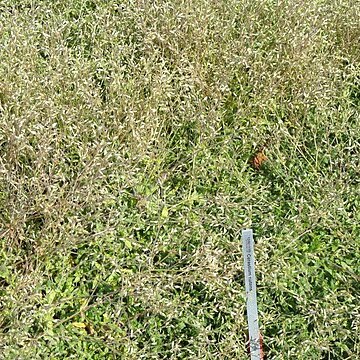Plants annual, slender, finely glandular-pubescent (often per-ennial and tomentose in var. obtectum), with slender taproot. Stems erect, simple or branched at or near base, sometimes with straggling, nonflowering basal shoots, 10-50 cm, softly pubes-cent, often with a few long, flex-uous, woolly hairs at proximal nodes, glandular and somewhat viscid distally; small axillary tufts of leaves usually absent. Leaves marcescent or not, sessile; blade oblanceolate to spatulate in proximal leaves, becoming lanceolate to linear-lanceolate in distal leaves, occasionally elliptic, 10-60 × 3-15 mm, apex acuminate to acute, softly pubescent and glandular, sometimes tomentose. Inflorescences rather open, 3-21(-40)-flowered cymes, ultimately widely branched; bracts herbaceous, lanceolate, glandular-pubescent. Pedicels ascending, sharply deflexed at apex in fruit, 5-20(-35) mm, usually 1-3 times as long as sepals in flower, elongating to 5 times as long as sepals in fruit, longer than capsules, glandular-pubescent and viscid. Flowers: sepals ovate-lanceolate, 4-6 mm, outer sepals herbaceous or with narrow margins, inner with margins ca. as wide as herbaceous center, apex broadly acute to obtuse, glandular-puberulent, hairs shorter than sepal tips; petals oblanceolate, sometimes absent, 3-6(-8) mm, shorter to 1.5 times longer than sepals, apex 2-fid; stamens 10; styles 5. Capsules cylindric, curved, (9-)10-12(-13) mm, 2-3 times as long as sepals; teeth 10, erect, margins convolute. Seeds golden brown, 0.5-0.8 mm diam., shallowly tuberculate; testa not inflated. 2n = 34, 36.
More
Viscid-pubescent annual 1–4.5 dm, mostly softer and leafier than our intr. spp.; lvs narrowly lance-oblong to oblanceolate, 1.5–5(–8) cm × 5–10(–13) mm, acutish; infl ± open, loosely cymose; bracts wholly herbaceous; sep 3.5–5 mm, relatively broad, thin, and blunt, thinly to fairly copiously provided with short to fairly long, sometimes gland-tipped hairs that do not surpass the sep-tip; pet from a little shorter to evidently longer than the sep; bifid to a depth of mostly 1–2 mm, or seldom wanting; stamens 10 or seldom (especially in apetalous forms) only 5; fr 8–15 mm, straight or curved, mostly 2–3 times as long as the sep. 2n=34–36. Woods and open places, sometimes in disturbed sites, but not so weedy as our intr. spp.; N.S. to Mack., s. to Ga., Ariz., and Oreg. Apr.–July. (C. brachypodum (A. Gray) B. L. Rob., the arbitrarily delimited, geographically coextensive phase with pedicels mostly 0.5–1.5 cm, instead of 1.5–4 cm as in typical material)

